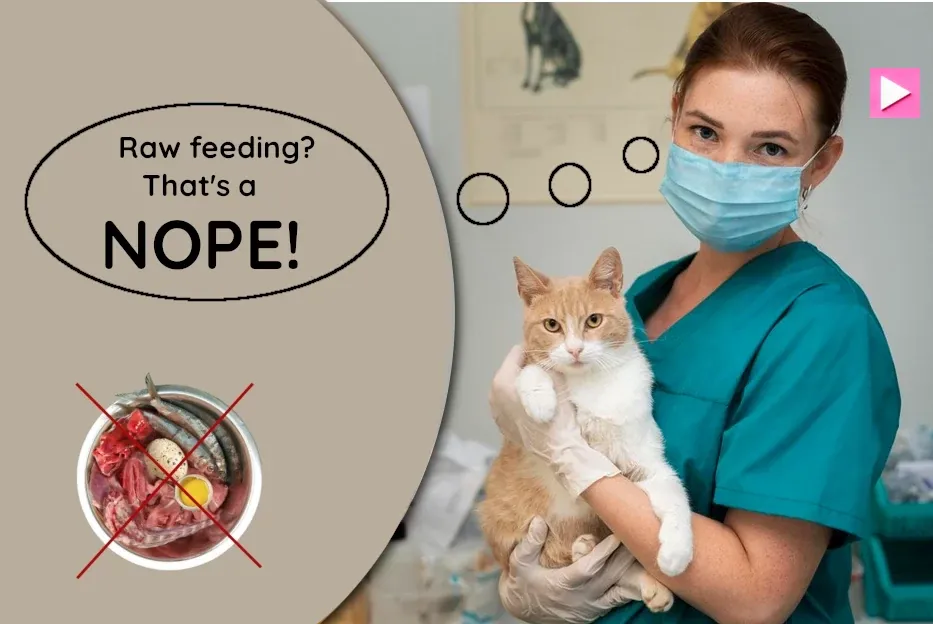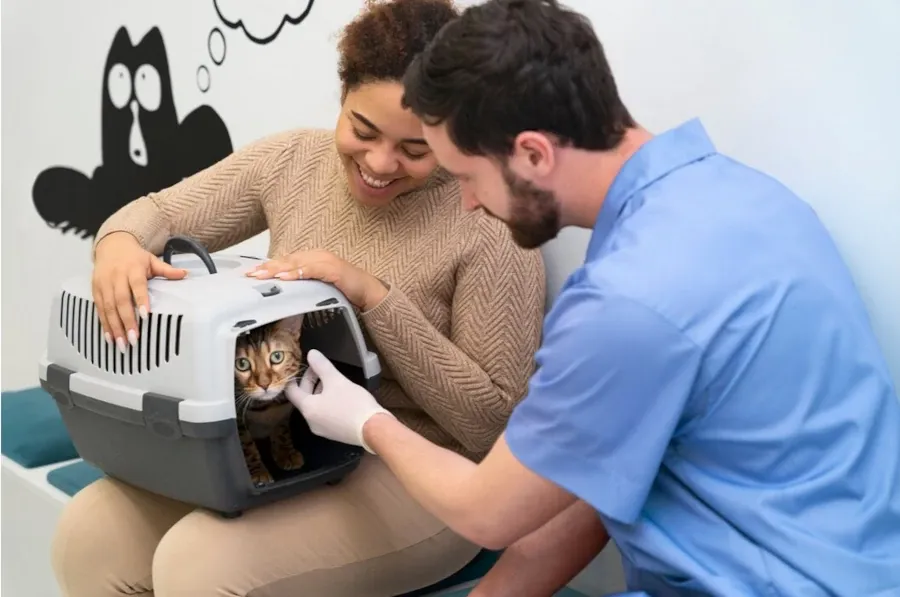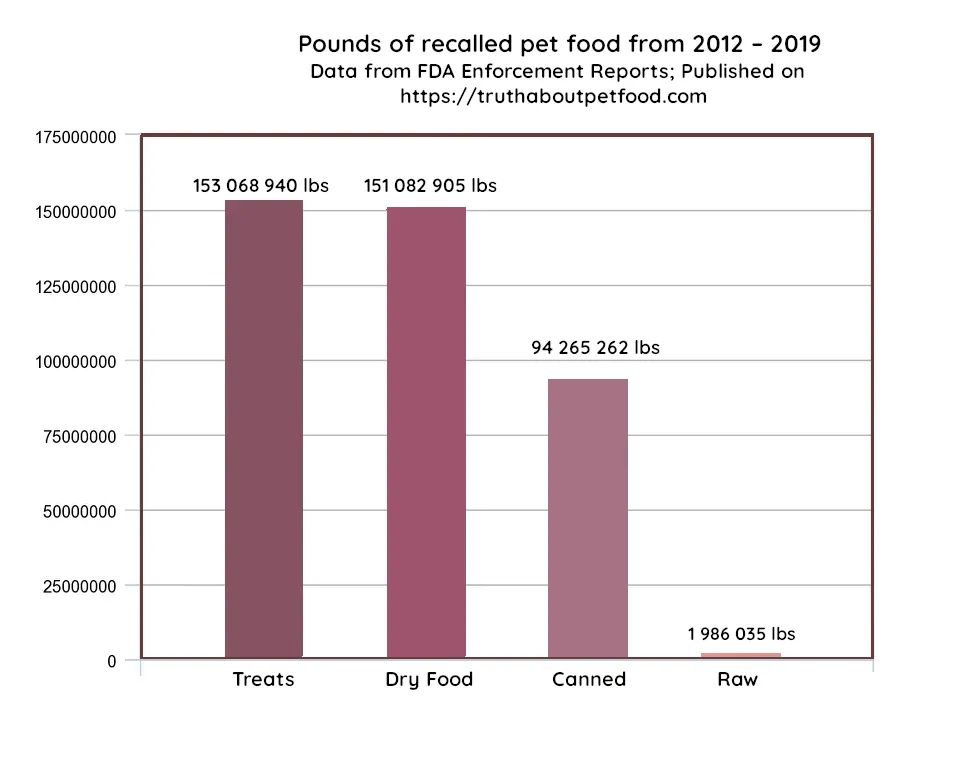Why Are Most Vets Against Raw Feeding? (And What To Do)
Most veterinarians will advise against raw feeding. The 7 most common reasons for this are delved into, as well as what cat carers can do to sway their vet. A more balanced view of these issues are also provided by placing them within context.

The common criticisms of raw feeding from veterinarians are first outlined. Then, how to bridge these divides and how to see these issues within context in a more balanced way are looked at.
The 7 most common issues raised by veterinarians
#1 Nutrition does not form part of veterinary training
Vets are trained extensively in animal medicine, whereas nutrition is a complex field of its own. Vets do not receive training in this highly specialised field. They can't provide the information or guidance they don’t have in their skill-set.
Their default is to rather steer clear of areas of feeding they are unfamiliar with and to fall back on commercial foods.
#2 Fear of pathogens
Bacteria can live on the surface of raw meat. And yes, they can undoubtedly be dangerous. Many veterinarians fear that preparing raw cat food can contaminate areas of the home.
They also fear that raw cat food may endanger the health of people in these households – especially children and immunocompromised individuals. And they fear that raw fed cats may shed and spread pathogens around homes.
#3 Health concerns
Cats can potentially break teeth on inappropriate raw bones. There have also been reports of intestinal blockages from unsuitable raw meaty bones. Most veterinarians feel that raw food is not safe for cats to eat.
#4 Fear of nutritional imbalances
A raw diet done incorrectly can lead to nutritional imbalances – some of which can be very serious.
Many veterinarians feel that they do not have sufficient control over how cats’ meals are constructed and whether the raw foods their clients prepare are nutritionally adequate.
#5 Lack of evidence of raw food benefits
Veterinarians feel that rigorous research studies into the benefits of raw diets are lacking. They assert that there is no real proof of benefits.
#6 Vets believe that commercial foods are safer
Veterinarians feel that the careful formulation and rigorous testing of commercial cat foods make them the safest option for cats.
#7 Veterinarians fear legal blow-back from raw feeders
Vets fear the legal ramifications from allowing a client to raw feed. They fear that, if anything goes wrong, they will be held accountable.

How to effectively overcome these issues
All responsible cat carers should have a balanced view of the food they feed their cats and not accept blindly what they are told by pet food manufacturers. It is our responsibility to look into the benefits and dangers of the foods we choose to use.
As for responsible raw feeders, we should be able to demonstrate satisfactorily to a veterinarian that we have covered the areas of concern and thereby build trust with them.
One must show that one has put in the work, is raw feeding responsibly and is taking the necessary safety precautions. To do this is not difficult, because putting in the work will automatically cover all of these bases – and so much more.
And this is not to impress anyone, but to ensure our safety, the safety of every member in a household and the safety of cats.
#1 Nutrition does not form part of veterinary training
Veterinarians who encourage raw feeding are those who take it upon themselves to educate themselves in this method, which is a growing trend. However, the majority of veterinarians still lack raw feeding expertise.
Therefore, prospective raw feeders need to take it upon themselves to adequately learn about raw feeding. There is a definite learning curve, but with the right guidance, it is easy.
However, there are veterinarians that will never be swayed by any level of competency. One might need to keep looking for a vet who will be prepared to have raw feeders as clients.
...seek and you shall find
In many cases, veterinarians will be prepared to work with responsible, educated raw feeding clients. They might even want to learn from you.
Luckily, there is a plethora of veterinarians that have sound knowledge of raw diets – and word about their existence usually spreads fast within raw feeding communities. All one needs to do is ask around.
#2 Fear of pathogens
This is the single most cited criticism that effectively shuts down the raw feeding debate before it even starts.
But most of us already know that raw meat can harbour dangerous pathogens. The majority of us prepare raw meat in our kitchens for our own meals.
As such, we know how to clean up correctly after raw meat handling. And we also know how to safely store raw meat. The same common sense and safe food handling practices are adequate to keep cats and households safe.
In addition, raw feeding areas and raw food should be inaccessible to small children. Immunocompromised individuals should steer clear of raw feeding areas, feeding vessels and food preparation areas.
As for healthy cats, they are well equipped to safely thrive on raw meat. Our nature mimicking chef school, that teaches raw feeding, will discuss the cat’s impressive ways to deal with raw animal tissue.
Tips, trick and ways to easily contain messy eaters and cats that exhibit unwanted feeding behaviours are also covered. Pathogens, fears of faecal bacterial shedding from raw diets and much more are explored by our raw feeding resources.
Notably, it is necessary to investigate all sides of an issue to form a more balanced, realistic view.
...remember that ALL pet foods can harbour dangerous pathogens
Overstating the dangers of raw food while ignoring the contamination dangers of commercial food is irresponsible, misleading and not helpful to anyone.
Most of us know about the potential dangers of raw meat and handle it accordingly. But few cat carers realise the dangers from pathogens in commercial cat foods and treats.
Most of us feel quite comfortable having these foods around small children and immunocompromised individuals.
To realise their dangers, we need only look at the endless waves of pet food recalls that are usually prompted by acute illness or even pet deaths 1. Susan Thixton, pet food safety watchdog, reported on recalls, in the US alone, from Salmonella, Listeria, E. coli and other bacteria 2.

These figures are for pathogen affected foods for the period between 2012 and 2019:
- More than 153 million pounds of processed pet treats (roughly 70 million kg);
- More than 151 million pounds of dry foods (over 69 million kg);
- Over 94 million pounds of canned food (almost 43 million kg).
Five years on, in 2024, imagine what recalled food volumes amount to now. Strangely, the fear of raw meat scares vets and cat carers away from raw feeding.
But the issue of mountains of contaminated processed pet foods that eclipse affected raw foods several hundred times over, is accepted without fear.
Yes, commercial foods are used much more widely than raw food. But Dr Karen Becker (DVM) has, for many years, asserted that the dangers from raw feeding are negligible measured against the dangers posed by commercial pet foods.
#3 Health concerns
Cats breaking teeth or suffering intestinal blockages from raw food is frightening. However, these safety concerns need to be viewed within the context of food dangers in general. Every food for every species comes with its own set of risks and dangers.
Complications from raw feeding can be prevented with the application of the right knowledge. Also, supervising cats while they learn the ropes of raw food will largely prevent such issues.
Regularly checking in and re-evaluating how cats are coping with raw food items, even after they are proficient raw eaters, will further curb potential problems.
But raw food dangers are isolated and not seen within the context of cat food in general. Most cat carers don’t realise that the use of commercial cat foods introduce a much wider set of health dangers that – by far – surpass those from raw food.
...raw feeding risks pale by comparison
In addition to the illness and deaths that precede endless streams of recalls, there are also a wide array of chronic illnesses cats succumb to from the continued use of biologically wrong foods 3, 4, 5, 6.
The inappropriate nature of dry commercial foods have been linked to kidney and urinary system diseases 3. Dr Pierson (DVM) states that feline kidney disease is the leading cause of mortality in house cats –and is mostly preventable with species appropriate foods.
The high carbohydrate content and inappropriate ingredients in most cat foods and treats cause metabolic diseases 7 and obesity 3. They also cause the high levels of inflammatory bowel disease and pancreas inflammation seen in cats 7.
Dental health decline, stomatitis and other oral diseases 8, 9, 10 and a range of cancers from toxins and carcinogens in cat food 7, 11 are further concerns.
Yet, cat carers and veterinarians embrace these foods fervently, while standing in judgement of raw feeders for being irresponsible with the health of their cats.
Plus, commercial foods – with all of their attached risks – are endorsed and promoted firmly as the only food cats should eat.
But let’s not forget that most cat carers explore raw feeding because their cat developed a health issue or health scare from ultra processed cat foods.
No one comes to raw feeding simply to seek attention or to be different – there is always a tragedy, a concern or a fear that underlies their decision to raw feed.
#4 Fear of nutritional imbalances
Without doubt, an unbalanced raw diet is one of the worst things you can feed your cat 12.
...never wing it!
Before even considering to switch to a raw diet, one needs to put in the work. One needs to find a raw feeding method that is reputable, trustworthy and well-established.
One has to learn all there is to know about this method and then fully commit to the protocol, following it closely to ensure safety and nutritional adequacy.
No exceptions can be made, unless one appoints a raw feline nutritionist or feeds a commercial raw food.
Few of us can go these routes and will end up joining a reputable raw feeding community and adopting a safe, tried and tested raw feeding protocol.
Luckily, there are many trustworthy, highly skilled raw feeding communities out there to learn from.
#5 Lack of evidence of raw food benefits
There is a lack of unbiased, independently funded studies into raw feeding benefits. Though the raw feeding industry is fast growing, it is still a burgeoning field compared to commercial cat food.

The elephant in the room is funding. The raw feeding industry simply does not have the funds to do independent research and produce empirical data to compete with commercial cat food giants.
Moreover, research, as it stands, does not offer a balanced view of any cat food in any way. Pet food giants are able to buy whatever research or result they want to put out there. As such, they focus on the positives of their foods and the negatives of competing products.
But know this: There are as few highly visible, accessible research studies on the benefits of raw feeding as there are on the negatives of commercial foods.
#6 Vets believe that commercial foods are safer
Despite the careful formulation and rigorous testing of commercial cat foods, they still pose a wide range of dangers – from pathogens to chemical contamination, dangerous objects in food (like broken metal machine parts or glass) to incorrect food formulations and more.
Believing that these foods are safe is inaccurate and uninformed. To drive this point home, recalls can be viewed publicly 1 and show the many dangers from commercial foods to anyone who cares to look.
And these do not include the many illnesses and health implications from commercial foods that are mistakenly attributed to something else, without it ever being linked back to the real cause.
#7 Veterinarians fear legal blow-back from raw feeders
Thankfully for vets but unfortunately for us, any issues from vet recommended and endorsed commercial products never reflect back them.
The legal ramifications of these foods are usually absorbed and worked out by powerful pet food manufacturers and their legal teams.
As for raw feeding clients, if they are educated, proficient and know what they are doing, the likelihood of any problems that could be blamed on veterinarians would be slim to none.
Raw feeding clients who have not put in the work and who do not know what they are doing are the ones who pose a real threat to veterinarians.
For any vets who care to explore raw feeding, the RFVS (Raw Feeding Veterinary Society), a UK base international community of veterinarians and raw feeding experts, was founded in 2014 12.
Their focus is to promote species appropriate nutrition and to educate other interested veterinarians on these feeding methods. Their aim is to help raw feeding gain the momentum and recognition it deserves.
Finally, we are the custodians of our animals. We should be well informed and expect more from our vets. We should not allow anyone to advise us from a place of inexperience to go against what we know is best for our cats.


References
1 US Food & Drug Administration (n.d.). Recalls & withdrawals. Retrieved July 3, 2024, from https://www.fda.gov/animal-veterinary/safety-health/recalls-withdrawals
2 Thixton, S. (2019). When second place is very bad. In Truth About Pet Food. Retrieved July3, 2024, from https://truthaboutpetfood.com/when-second-place-is/
3 Pierson, L.A. (n.d.). Feeding your cat: Know the basics of feline nutrition. In Cat Info. Retrieved July 4, 2024, from http://catinfo.org/
4 Becker, K.S. (2021). Top kibble myths – busted! In Healthy Pets. Retrieved July 4, 2024, from https://healthypets.substack.com/p/dry-dog-food-myths?utm_source=publication-search
5 Diaz, G. (2015). Answers: What Dry Food Does to Your Cat's Pee. In Hare Today (Feline Nutrition Foundation Archive). Retrieved July 4, 2024, from https://hare-today.com/feline-nutrition/answers/answers-what-dry-food-does-to-your-cat-s-pee
6 Jankovic, Z.D. (2011). Raw, as nature intended. The Dot Connector Magazine, 2(14), 92 – 98.
7 Hofve, J. (2022). 10 Reasons why dry food is bad for cats & dogs. In Little Big Cat. Retrieved on March 3, 2022 from https://littlebigcat.com/why-dry-food-is-bad-for-cats-and-dogs/#
8 Lonsdale, T. (1995). Periodontal disease and leucopenia. Journal of Small Animal Practice, 36, 542 – 546.
9 Diaz, G. (2015). Answers: What dry food does to your cat’s teeth. In Hare Today (Feline Nutrition Foundation Archive). Retrieved July 11, 2023, from https://hare-today.com/feline-nutrition/answers/answers-what-dry-food-does-to-your-cats-teeth
10 Jordan, P. (2012). Feeding the carnivore companion. In Pet Welfare Alliance. Ebook retrieved April, 20, 2024 from https://www.petwelfarealliance.org/free-stuff-and-resources.html
11 Hofve, J. (n.d.). Kibble-cancer link explained. In Little Big Cat. Retrieved July 06, 2023, from https://littlebigcat.com/kibble-cancer-link-explained/
12 Raw Feeding Veterinary Society: https://rfvs.info/about-us/
Disclaimer
The information provided on the Bestfedcats.com website is educational and informational. We are here to give guidance on how to feed a properly balanced raw diet. We also offer advice on how to improve the diet of the modern house cat. Please note that we are not veterinarians. We are not here to give veterinary advice. Best Fed Cats will not be held responsible for any adverse reactions to your cat based on the information on our website. The health of your cat depends entirely on you. We expect you to use your knowledge of your cats, their circumstances and their health – in conjunction with a trusted veterinarian – to determine if any advice provided on this site is appropriate for your cats.

